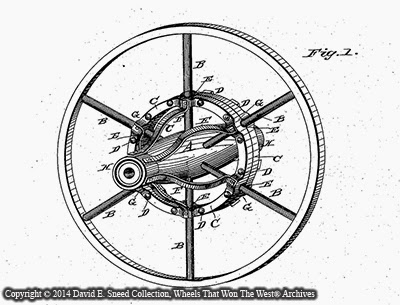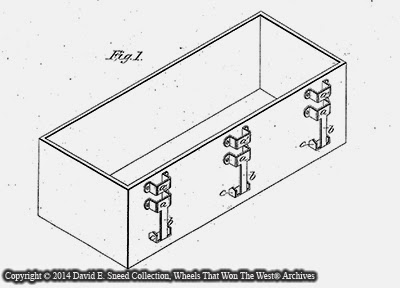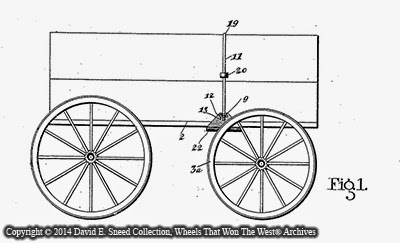There are a number of early vehicle-related patents that were so well accepted that they became common in commercial use back in the day. The successes of inventors with last names such as Sandage, Comstock, Burr, Archibald, Stoddard, and Sarven are well documented and were equally well-known by vehicle builders in the 1800s and early 1900s. You may have heard of the 'Sandage skein' or the 'Archibald hub' or even the 'Comstock end gate' as I had covered earlier this year.
There are countless other expired patents that most living souls have never heard of and, if it weren't for this blog, they might be completely forgotten. That's not to say that you're missing much as many of those patents never got off the ground. Some failed completely while others saw only a glimmer of success. As a result, the odds of finding most of them today are in the neighborhood of 'slim to none.'
That said, several years ago, I came across a device clamped to the hub and spokes of a wagon wheel. It looked like a steel spider with the wooden wheel firmly in its grip. To understand its purpose one needs to look no further than the weaknesses faced by wooden wheels. No matter the end user - farmer, rancher, miner, business owner, freighter, etc. - many faced the eventual challenge of loose spokes, felloes, and tires as well as shrinkage and unsoundness in the hubs. As with the multitude of vehicle problems that can surface today, the issues often occurred when help was not close at hand. This particular spider-like clamp was engineered to stiffen and reinforce the entire body of the wheel - hub, spokes, and felloes - while helping temporarily fix a serious concern. Even though I'd stumbled upon the device in the 21st century, it's an idea with roots over 130 years old. The following illustration outlines the concept. It's from a patent applied for in 1883.
 |
| Many issues can cause weakness in wooden wheels. Sometimes a quick fix was needed before a more permanent repair could be made. |
A few years earlier, in 1880, another gentleman believed he had the answer for strengthening and stabilizing wagon bows. This design called for framed slots made of cast metal that would contain the ends of a wagon bow, preventing it from over-flexing or slipping down on the box lower than it should. Both scenarios could result in breakage and other problems. The image shown below is from that patent.

As reflected in this 1880 wagon bow innovation, patents and special design innovations covered virtually every aspect of a wagon's construction.
While patent applications related to wagons did slow down after the introduction of the automobile, there continued to be those willing to spend money to register their ideas well into the 20th century. Below is an approved patent that combined box tighteners with rub irons - two features with totally different functions. Essentially, a box tightener is a large clamp that helped seal the side(s) of a wagon box equipped with multiple sideboards. On the other hand, a rub iron is a metal shield designed to protect the lower box sides from being damaged when the front wheel is turning.

This idea for a combined rub iron and box tightener was filed in 1919 - a bit late for any real commercial success with wooden wagons.
It's always interesting to flip through the dusty pages of these old patent files. After all, we're all connected to yesterday and many of those early innovations are still being used in some way or another. So, while you're traveling through each day, keep your eyes open for different-looking pieces and don't be afraid to ask questions. Luck happens a lot more often when you work at it.